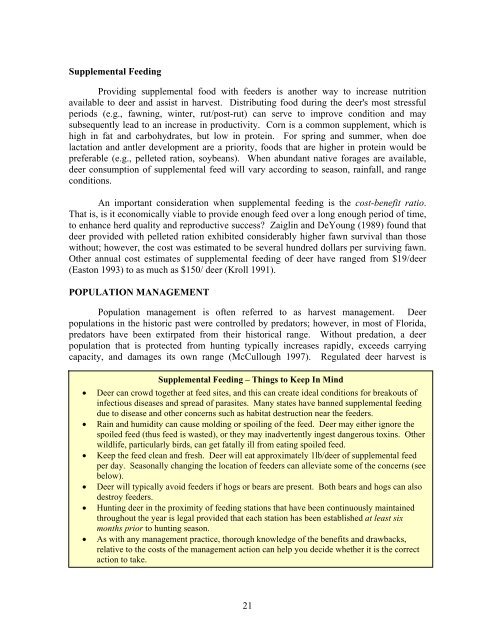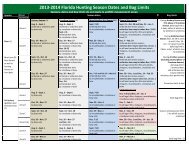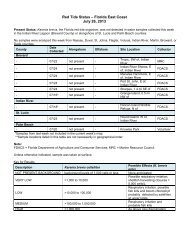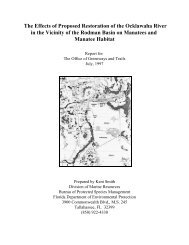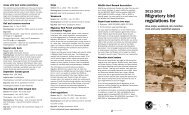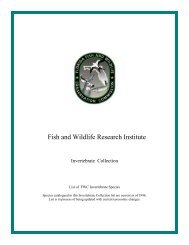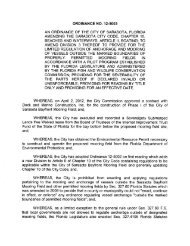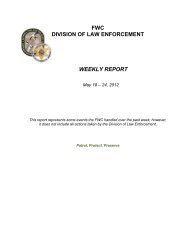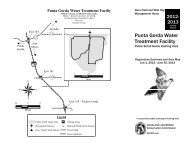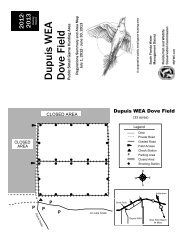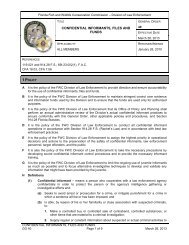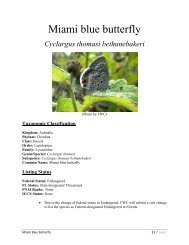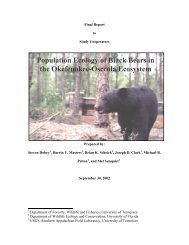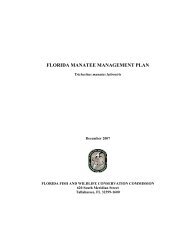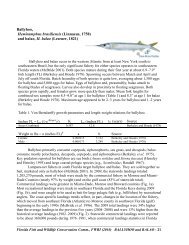Ecology and management of white-tailed deer in - Florida Fish and ...
Ecology and management of white-tailed deer in - Florida Fish and ...
Ecology and management of white-tailed deer in - Florida Fish and ...
You also want an ePaper? Increase the reach of your titles
YUMPU automatically turns print PDFs into web optimized ePapers that Google loves.
Supplemental Feed<strong>in</strong>g<br />
Provid<strong>in</strong>g supplemental food with feeders is another way to <strong>in</strong>crease nutrition<br />
available to <strong>deer</strong> <strong>and</strong> assist <strong>in</strong> harvest. Distribut<strong>in</strong>g food dur<strong>in</strong>g the <strong>deer</strong>'s most stressful<br />
periods (e.g., fawn<strong>in</strong>g, w<strong>in</strong>ter, rut/post-rut) can serve to improve condition <strong>and</strong> may<br />
subsequently lead to an <strong>in</strong>crease <strong>in</strong> productivity. Corn is a common supplement, which is<br />
high <strong>in</strong> fat <strong>and</strong> carbohydrates, but low <strong>in</strong> prote<strong>in</strong>. For spr<strong>in</strong>g <strong>and</strong> summer, when doe<br />
lactation <strong>and</strong> antler development are a priority, foods that are higher <strong>in</strong> prote<strong>in</strong> would be<br />
preferable (e.g., pelleted ration, soybeans). When abundant native forages are available,<br />
<strong>deer</strong> consumption <strong>of</strong> supplemental feed will vary accord<strong>in</strong>g to season, ra<strong>in</strong>fall, <strong>and</strong> range<br />
conditions.<br />
An important consideration when supplemental feed<strong>in</strong>g is the cost-benefit ratio.<br />
That is, is it economically viable to provide enough feed over a long enough period <strong>of</strong> time,<br />
to enhance herd quality <strong>and</strong> reproductive success? Zaigl<strong>in</strong> <strong>and</strong> DeYoung (1989) found that<br />
<strong>deer</strong> provided with pelleted ration exhibited considerably higher fawn survival than those<br />
without; however, the cost was estimated to be several hundred dollars per surviv<strong>in</strong>g fawn.<br />
Other annual cost estimates <strong>of</strong> supplemental feed<strong>in</strong>g <strong>of</strong> <strong>deer</strong> have ranged from $19/<strong>deer</strong><br />
(Easton 1993) to as much as $150/ <strong>deer</strong> (Kroll 1991).<br />
POPULATION MANAGEMENT<br />
Population <strong>management</strong> is <strong>of</strong>ten referred to as harvest <strong>management</strong>. Deer<br />
populations <strong>in</strong> the historic past were controlled by predators; however, <strong>in</strong> most <strong>of</strong> <strong>Florida</strong>,<br />
predators have been extirpated from their historical range. Without predation, a <strong>deer</strong><br />
population that is protected from hunt<strong>in</strong>g typically <strong>in</strong>creases rapidly, exceeds carry<strong>in</strong>g<br />
capacity, <strong>and</strong> damages its own range (McCullough 1997). Regulated <strong>deer</strong> harvest is<br />
Supplemental Feed<strong>in</strong>g – Th<strong>in</strong>gs to Keep In M<strong>in</strong>d<br />
• Deer can crowd together at feed sites, <strong>and</strong> this can create ideal conditions for breakouts <strong>of</strong><br />
<strong>in</strong>fectious diseases <strong>and</strong> spread <strong>of</strong> parasites. Many states have banned supplemental feed<strong>in</strong>g<br />
due to disease <strong>and</strong> other concerns such as habitat destruction near the feeders.<br />
• Ra<strong>in</strong> <strong>and</strong> humidity can cause mold<strong>in</strong>g or spoil<strong>in</strong>g <strong>of</strong> the feed. Deer may either ignore the<br />
spoiled feed (thus feed is wasted), or they may <strong>in</strong>advertently <strong>in</strong>gest dangerous tox<strong>in</strong>s. Other<br />
wildlife, particularly birds, can get fatally ill from eat<strong>in</strong>g spoiled feed.<br />
• Keep the feed clean <strong>and</strong> fresh. Deer will eat approximately 1lb/<strong>deer</strong> <strong>of</strong> supplemental feed<br />
per day. Seasonally chang<strong>in</strong>g the location <strong>of</strong> feeders can alleviate some <strong>of</strong> the concerns (see<br />
below).<br />
• Deer will typically avoid feeders if hogs or bears are present. Both bears <strong>and</strong> hogs can also<br />
destroy feeders.<br />
• Hunt<strong>in</strong>g <strong>deer</strong> <strong>in</strong> the proximity <strong>of</strong> feed<strong>in</strong>g stations that have been cont<strong>in</strong>uously ma<strong>in</strong>ta<strong>in</strong>ed<br />
throughout the year is legal provided that each station has been established at least six<br />
months prior to hunt<strong>in</strong>g season.<br />
• As with any <strong>management</strong> practice, thorough knowledge <strong>of</strong> the benefits <strong>and</strong> drawbacks,<br />
relative to the costs <strong>of</strong> the <strong>management</strong> action can help you decide whether it is the correct<br />
action to take.<br />
21


